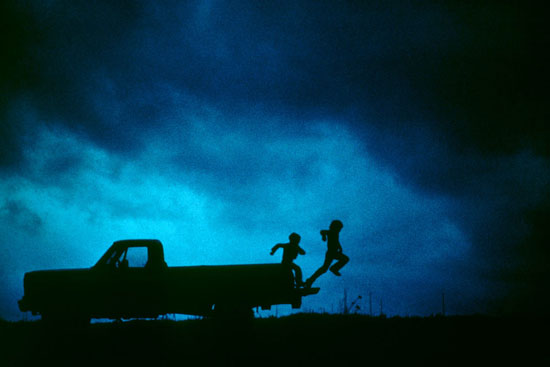The Bean boys on their farm in Whitefield, NH, May 2, 1986. From the back inside cover of A Day In the Life of America. Photo by S. Peter Lewis
Flashback to May 2, 1986 and the day that changed my photographic life
In the fall of 1985 there was great buzz in the photo world as news began to trickle out that Rick Smolan and David Cohen were getting ready for their next bold and enormous “day in the life” project: A Day in the Life of America. I was in my mid 20s, had just started doing some freelance photography, and was enthralled with this audacious plan to capture America on film* in a single day.
I was working as a mountain guide in New Hampshire at the time, and it turned out that one of the 200 photographers assigned for the May 2, 1986 shoot, was Pulitzer Prize winner Jay Dickman, of the Dallas Times Herald. He was assigned to shoot for the day on top of Mount Washington, the highest peak in the Northeast and home to the renowned Mount Washington Weather observatory. It would still be wintery up there in early May, so shooting with the weather observers up in the alpine zone would make for great shots. I knew the mountain quite well, since it was basically in my back yard and I had climbed it many times—and then I found out that our climbing school director, my dear friend Joe Lentini, had been contacted by Smolan’s team because they felt that Dickman should have guides with him on what was widely regarded as a place having the worse weather in the world. Joe was going to be the lead guide, and knowing my photographic aspirations, he asked me if I wanted to come along as an assistant guide. I would get to help lug Dickman’s gear around above timberline and help make sure everyone stayed safe. Would I get to take photos? No. But still, what a cool thing to be involved with, right? I went home so excited and told my wife the great news. Then I got to thinking…
The next day I told Joe thank you, but no.
I didn’t want to schlep Dickman’s gear around, and I didn’t want to keep anybody safe. I didn’t want to help someone else get a photo in the book, I wanted to shoot a photo for the book. And while the odds were slim to none, I might just be able to do it; because Smolan and Cohen, those savvy business guys, had promised to include images in the book not just from the 200 assigned bigshot photographers, but also from ordinary people across America. It would be everyone’s project. They wouldn’t print very many images from the public, but hey, everyone had a chance. Which meant that I had a chance.
Now I just had to decide what to shoot. A few months before I had shot an assignment for a New Hampshire magazine, and one of the locations was Bearnie Bean’s family dairy farm, in Whitefield. I couldn’t think of a more “American” theme than life on a struggling New England farm, so I called Bernie, reminded him of who I was (I’d only spent about an hour at his farm shooting the magazine assignment), and pitched the idea of spending May 2 with his family. Bernie couldn’t have been nicer and he immediately invited me to spend the night of May 1 at his house, and gave me free range on the farm (so to speak).
Feeling a bit awkard (I barely knew these people), I showed up the evening before the big day, and the Beans couldn’t have been nicer; I basically became an instant member of their family. After supper, I was shown to my room, and Bernie told that I should turn in early, because the next day would start pretty early. At 4:30 the next morning the blaring of the Bean’s radio rocked me out of bed. Stumbling downstairs in the dark I found the kitchen to be bustling with activity, with every family member, including the two youngest boys, at the breakfast table getting ready for another day on the dairy.
Bernie had told me that it took everyone’s effort to get everything done (there were a lot of cows), and that while he wouldn’t have time to lead me around and tell me all that was going on, I was free to wander around and shoot anything I pleased. And so I spent the day, mostly with the two youngest Bean boys (about 10 or 12, I would guess), and they showed me everything. We scurried nt in and out of barns, clambered up and down ladders, and sloshed through the spring mud down to the pasture. And everywhere were the cows and the industry of milking. At the end of the day, having shot almost five rolls of film (about 180 images**), I wasn’t sure if I got anything good (remember, I couldn’t see any of my shots), and as the clouds built up and the light dimmed, I knew I was running out of time. And then I got one last idea, and I found Bernie and asked him if I could take the boys up to the top of the hill behind the farm. He tossed me the keys to his old pickup, the boys jumped in, and we drove up an old pasture road. I parked the pickup at the crest of the hill, put the distant and stormy sky in the background, and asked the boys to run and jump out of the truck bed. With my longest lens and my widest aperture, I knelt in the wet grass and popped off the last few frames of the day.
What followed was a long and anxious week as I waited for my film to be processed. When I finally got all the images back I rifled through each box in the order that I had shot them, holding each slide up to the light shining through our living room window. As each box came and went my spirits sagged. Snapshots, just snapshots. And then, at the end of the last stack of slides in the last box, I saw it. One. Great. Frame. The two Bean boy leaping off the back of Bernie’s truck, each silhouetted against an angry sky, with perfect separation between each of them and between each churning leg and pumping arm.
Each public shooter was allowed to submit just two images to the Day in the Life of America people, and so I took the truck shot, plus one more passable throw-away slide, dropped them in the mail, and waited. A few days later my phone rang. It was Rick Smolan’s office from A Day in the Life. They wanted the shot of the boys, and (brace yourself), they were considering it for the cover.
In the end, they used the shot on the inside back cover, and their decision was based on chronology: the photo they used for the front cover was also a silhouette, of a cowboy on a horse, and it was taken at dawn, while my pick was taken in the evening. I was disappointed, but it made sense.
That shot of the Bean boys was a proud moment, and still is. It gave me the confidence to know that my work could be good enough, jumpstarting a career that is still going on decades later. The photo didn’t make me a dollar, and you can still find the big book in yard sales for a couple of bucks. But to me, the shot is priceless.
*Yes, film used to be a thing
** This is hysterical; in these digital days it isn’t unusual for me to shoot a thousand frames in a day. Back then film was expensive; these days pixels are essentially free.


